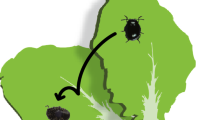Abstract
Because shelter-building herbivorous insect species often consider structural features of their host plants in selecting construction sites, their probability of attack is likely to be a function of some combination of plant architectural traits and leaf quality factors. We tested the hypothesis that plant architecture, in the form of the number of touching leaves, influences interspecific variation in attack by leaf-tying caterpillars in five species of sympatric Missouri oaks (Quercus). We compared colonization on control branches, in which both architecture and leaf quality were potentially important, with colonization on experimental branches for which we controlled for the effects of architecture by creating equal numbers of artificial ties. Colonization of artificial ties was highly correlated with natural colonization on neighboring control branches, suggesting that leaf quality factors and not architecture influenced interspecific variation in attack by leaf-tying caterpillars. Of the leaf quality factors measured (water, protein-binding capacity, nitrogen, specific leaf area, pubescence, and toughness), nitrogen was the most explanatory. With the exception of white oak, natural leaf tie colonization was positively correlated with nitrogen availability (ratio of nitrogen to protein-binding capacity), and negatively correlated with protein-binding capacity of leaf extracts. Both host plant species and subgenus oak influenced the community composition of leaf-tying caterpillars and the non-tying symbionts colonizing the ties. Host plant differences in leaf nitrogen content were positively correlated with pupal weight of one of two caterpillar species reared on all five host plant species. Thus, interspecific differences in nitrogen, nitrogen availability, and protein-binding capacity of leaf extracts are the best predictors at this time of interspecific differences in attack by leaf-tying caterpillars, in turn affecting their success on individual host plants in the laboratory.








Similar content being viewed by others
References
Carroll MR, Kearby WH (1978) Microlepidopterous leaf tiers (Lepidoptera: Gelichioidea) in central Missouri. J Kans Entomol Soc 51:457–471
Ehrlich PR, Raven PH (1964) Butterflies and plants: a study in coevolution. Evolution 18:586–608
Feeny P (1970) Seasonal changes in oak leaf tannins and nutrients as a cause of spring feeding by winter moth caterpillars. Ecology 51:565–581
Forkner RE, Marquis RJ, Lill JT (2004) Feeny revisited: condensed tannins as anti-herbivore defences in leaf-chewing herbivore communities of Quercus. Ecol Entomol 29:174–187
Fraenkel GS (1959) The raison d’etre of secondary plant substances. Science 129:1466–1470
Fukui A (2001) Indirect interactions mediated by leaf shelters in animal-plant communities. Popul Ecol 43:31–40
Hagerman AE (1987) Extraction of tannin from fresh and preserved leaves. J Chem Ecol 14:1561–1573
Jones CG, Lawton JH, Shashak M (1997) Positive and negative effects of organisms as ecosystem engineers. Ecology 78:1946–1957
Lawton JH (1983) Plant architecture and the diversity of phytophagous insects. Annu Rev Entomol 28:23–39
Lill JT, Marquis RJ (2001) The effects of leaf quality on herbivore performance and attack from natural enemies. Oecologia 126:418–428
Lill JT, Marquis RJ (2003) Ecosystem engineering by caterpillars increases insect herbivore density on white oak. Ecology 84:682–690
Lill JT, Marquis RJ (2007) Microhabitat manipulation: ecosystem engineering by shelter-building insects. In: Cuddington K, Byers JE, Wilson WG, Hastings A (eds) Ecosystem engineers: plant to protists. Elsevier, San Diego, pp 107–138
Marquis RJ, Lill JT (2006) Effects of herbivores as physical ecosystem engineers on plant-based trophic interaction webs. In: Ohgushi T, Craig TP, Price PW (eds) Indirect interaction webs: non-trophic linkages through induced plant traits. Columbia University Press, New York
Marquis RJ, Lill JT, Piccini A (2002) Effect of plant architecture on colonization and damage by leaf-tying caterpillars of Quercus alba. Oikos 99:531–537
McCune B, Grace JB (2002) Analysis of ecological communities. MJM Software Design, Gleneden Beach
McCune B, Mefford MJ (1999) PC-ORD. multivariate analysis of ecological data, version 4. MJM Software Design, Gleneden Beach
Singer MS, Stireman JO III (2005) The tri-trophic niche concept and adaptive radiation of phytophagous insects. Ecol Lett 78:1356–1369
Wise MJ, Abrahamson WG (2008) Ducking as a means of resistance to herbivory in tall goldenrod, Solidago altissima. Ecology 89:3275–3281
Wold EN, Marquis RJ (1997) Induced defenses in white oak: effects on herbivores and consequences for the plant. Ecology 78:1356–1369
Acknowledgments
We thank Bruce Schuette and the Missouri Department of Natural Resources for access to Cuivre River State Park, and John Flunker, John Landosky, Nick Barber, Beatriz Baker and two anonymous reviewers for comments on earlier versions of this manuscript. Financial support was provided by the University of Missouri-St. Louis, NSF BIR-941994, and USDA 99-35302-8017.
Author information
Authors and Affiliations
Corresponding author
Additional information
Communicated by Phyllis Coley.
Rights and permissions
About this article
Cite this article
Marquis, R.J., Lill, J.T. Impact of plant architecture versus leaf quality on attack by leaf-tying caterpillars on five oak species. Oecologia 163, 203–213 (2010). https://doi.org/10.1007/s00442-009-1519-2
Received:
Accepted:
Published:
Issue Date:
DOI: https://doi.org/10.1007/s00442-009-1519-2




